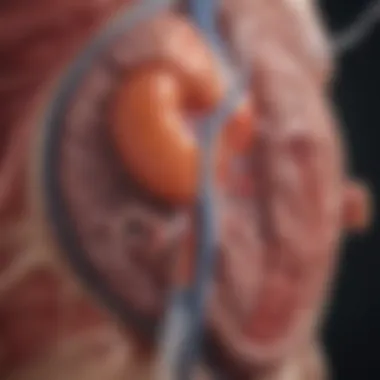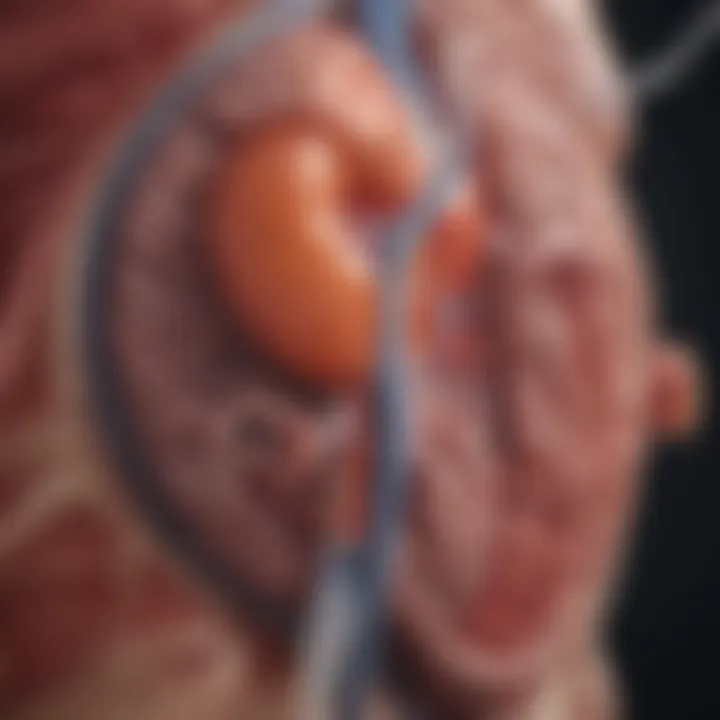Chronic Kidney Disease: Dialysis and Transplant Insights


Article Overview
Purpose of the Article
The purpose of this article is to provide a detailed exploration of chronic kidney disease (CKD), specifically focusing on the significant roles of dialysis and kidney transplantation. CKD is a progressive condition that affects millions of people globally. Understanding the complexities of CKD and the treatments available is crucial for patients, caregivers, and healthcare professionals. By explaining these treatment options, this article aims to shed light on how they can enhance patient outcomes, thus improving lives.
Relevance to Multiple Disciplines
Chronic kidney disease impacts various fields beyond nephrology. It intersects with public health, sociology, and nutrition. Medical professionals must collaborate across disciplines to manage CKD effectively. Therefore, understanding CKD not only aids nephrologists but also benefits dietitians, psychologists, and social workers who support affected individuals. This multi-disciplinary approach reinforces the importance of education and awareness.
Research Background
Historical Context
The understanding of chronic kidney disease has evolved significantly over the past decades. Initially, renal disorders were often attributed to external factors without considering underlying pathophysiology. More recent research highlights how conditions such as diabetes and hypertension contribute to CKD. This shift in perspective is critical for developing targeted therapies and improving patient education.
Key Concepts and Definitions
To grasp the complexities of CKD and its treatments, specific terms must be clarified. CKD is characterized by a gradual loss of kidney function over time. Dialysis is a treatment that artificially removes waste products from the blood when kidneys can no longer perform this function. There are two main types: hemodialysis and peritoneal dialysis. Kidney transplantation involves replacing a damaged kidney with a healthy one from a donor. Each of these options presents unique challenges and benefits, which will be explored in detail throughout the article.
"Effective management of chronic kidney disease requires comprehensive understanding and collaboration among various health disciplines."
"Effective management of chronic kidney disease requires comprehensive understanding and collaboration among various health disciplines."
Both dialysis and kidney transplantation are influential in maintaining the quality of life for patients with advanced CKD. However, the choice between these methods involves consideration of multiple factors including patient preference, overall health, and availability of resources. This article aims to present information that supports informed decision-making in this regard.
Chronic Kidney Disease Overview
Chronic kidney disease (CKD) represents a significant public health challenge worldwide. The importance of understanding CKD cannot be overstated, as it affects millions of individuals and has profound implications for overall health. This condition is characterized by a gradual loss of kidney function over time. If left unmanaged, CKD can lead to end-stage renal disease (ESRD), necessitating dialysis or transplantation for survival. Therefore, recognizing the early signs and risk factors associated with CKD can lead to timely intervention and better patient outcomes.
Within the framework of CKD, several key elements warrant attention. Detection and classification of kidney damage are critical. The disease can manifest in various forms, each requiring different treatment approaches. Moreover, comprehending the epidemiological data surrounding CKD provides insight into the demographics at greatest risk. This knowledge can inform public health strategies and enhance resource allocation for at-risk populations.
Given the progressive nature of CKD, an understanding of its etiology is also essential. Numerous underlying factors, such as diabetes and hypertension, contribute to the development of CKD. By exploring the causal relationships, healthcare professionals can tailor preventive measures and treatment plans effectively.
In summary, chronic kidney disease is more than a medical condition; it encapsulates a complex interaction of biological, social, and environmental factors. The subsequent sections in this article will delve deeper into these aspects, providing a comprehensive framework for understanding CKD.
Definition and Classification
CKD is defined as a condition marked by reduced kidney function lasting three months or more. The classification of CKD is often based on the glomerular filtration rate (GFR) and the presence of kidney damage as evidenced by structural abnormalities or markers of kidney injury. The stages of CKD range from stage 1, where kidney function remains normal but there are signs of damage, to stage 5, which is kidney failure requiring dialysis or transplantation.
Epidemiology and Prevalence
The global prevalence of CKD is rising, with varying reports suggesting it affects approximately 10-15% of the adult population. Risk factors such as age, ethnicity, and presence of comorbidities significantly influence this statistic. Understanding who is affected by CKD helps shape screening efforts and preventive strategies.
Etiology of Chronic Kidney Disease
CKD has a multifactorial etiology. Diabetes mellitus and hypertension are the leading causes, accounting for the majority of cases. Other contributing factors include chronic glomerulonephritis, polycystic kidney disease, and prolonged use of certain medications. Each of these factors underscores the need for a tailored approach to prevention and management.
Pathophysiology of Kidney Damage
Understanding the pathophysiology of kidney damage is fundamental for grasping the mechanisms underlying chronic kidney disease (CKD). The kidneys play a central role in maintaining homeostasis within the body. They filter waste products and excess fluids, regulate electrolyte balance, and manage blood pressure. When kidney function declines, the body experiences a cascade of biological changes that can lead to severe complications. This section delves into the intricate processes that result in kidney damage and the implications for overall health.
Glomerular Function and Structure
The glomerulus is a key component in the kidney's filtration system. It consists of a network of tiny blood vessels that filter blood, removing waste while retaining essential proteins and cells. Dysfunction in the glomerulus often marks the onset of CKD. Various factors, including diabetes and hypertension, can cause damage to this vital structure. This damage leads to increased permeability of the glomerular membrane, allowing proteins to leak into the urine.
As proteins are supposed to stay in the bloodstream, their loss affects the body's ability to maintain proper oncotic pressure, potentially leading to edema and further complications. Monitoring glomerular filtration rate (GFR) becomes a crucial part of managing CKD, as it helps assess the extent of kidney impairment.
Progressive Nature of CKD
Chronic kidney disease is characterized by its progressive and often irreversible nature. Initially, patients may not exhibit significant symptoms, leading to a delayed diagnosis. However, as the condition worsens, kidney function diminishes, which may lead to end-stage renal disease (ESRD). The progression can be influenced by a range of factors, including underlying health conditions, age, and lifestyle choices.
Renal adaptations, such as hypertrophy of the remaining functional nephrons, can initially compensate for the loss of function. However, this compensatory mechanism is unsustainable in the long term. Continuous damage can result in fibrosis and glomerulosclerosis, further diminishing renal capacity and function. Understanding this progressive nature helps in identifying appropriate interventions and management strategies.
Complications Associated with CKD
CKD is not merely a renal issue; it carries several complications that can significantly impact patient quality of life. Among the most common complications are:
- Cardiovascular disease: Patients with CKD are at heightened risk for cardiovascular events, largely due to the intertwining nature of renal and vascular health.
- Mineral and bone disorder: Imbalances in calcium, phosphorus, and vitamin D metabolism lead to bone disease and cardiovascular complications.
- Anemia: The kidneys produce erythropoietin, a hormone that stimulates red blood cell production. In CKD, insufficient levels can lead to anemia.
- Metabolic acidosis: The impaired ability of the kidneys to excrete acids causes a build-up, disrupting normal bodily functions.
"The presence of multiple complications in CKD underscores the need for an integrated approach to treatment."
"The presence of multiple complications in CKD underscores the need for an integrated approach to treatment."
Managing these complications is imperative for improving outcomes and prolonging life expectancy in patients with CKD. Regular monitoring and prompt treatment interventions are essential components of care plans.
The pathophysiology of kidney damage is complex, but gaining a deeper understanding aids healthcare professionals in effectively managing CKD. Knowledge of the kidney's structure, the progressive nature of the disease, and potential complications forms a solid foundation for effective interventions.
Diagnosis and Assessment of CKD


Diagnosis and assessment of chronic kidney disease are critical aspects of managing this condition effectively. Early detection can significantly alter the trajectory of CKD. It can lead to timely interventions, potentially delaying the progression to end-stage kidney disease. Assessing CKD involves a careful review of symptoms, laboratory testing, and staging, allowing healthcare providers to tailor treatment to individual patient needs.
Clinical Presentation and Symptoms
Patients with chronic kidney disease may present with a variety of symptoms. Some people may experience no symptoms in the early stages. However, as CKD progresses, symptoms can become more pronounced. Common clinical manifestations include:
- Fatigue: A general feeling of tiredness often results from an accumulation of wastes in the blood.
- Swelling: Fluid retention commonly leads to swelling in the legs, ankles, and around the eyes.
- Changes in urination: Patients might notice increased frequency of urination, especially at night, or a decrease in urine output.
- Nausea and vomiting: These symptoms may arise as waste products build up in the body.
Recognizing these symptoms is vital for prompt diagnosis and management.
Laboratory Testing and Imaging
Laboratory tests are essential for assessing kidney function and diagnosing CKD. Key tests include:
- Serum creatinine: Measures the level of creatinine in the blood as an indicator of kidney function. Elevated levels suggest diminished kidney function.
- Glomerular filtration rate (GFR): Calculated based on serum creatinine levels, age, sex, and race. A GFR less than 60 mL/min/1.73 m² for three months or more indicates possible CKD.
- Urinalysis: To check for protein or blood in the urine, which can signal kidney damage.
Imaging studies, such as ultrasound or CT scans, may also be utilized to evaluate the kidneys' structure and size.
Staging of Chronic Kidney Disease
Staging CKD helps healthcare providers assess the severity of the disease and plan appropriate treatment. CKD is divided into five stages based on GFR:
- Stage 1: GFR ≥ 90 mL/min with normal or increased kidney damage.
- Stage 2: GFR 60-89 mL/min with mild decrease in kidney function.
- Stage 3: GFR 30-59 mL/min with moderate decrease.
- Stage 4: GFR 15-29 mL/min indicating severe decrease in kidney function.
- Stage 5: GFR 15 mL/min, also known as end-stage kidney disease requiring dialysis or transplantation.
Understanding these stages aids in monitoring disease progression and implementing timely interventions. \n
Accurate diagnosis and assessment of chronic kidney disease can lead to improved outcomes and long-term management.
Accurate diagnosis and assessment of chronic kidney disease can lead to improved outcomes and long-term management.
Management Strategies for CKD
Managing chronic kidney disease (CKD) is vital to prolonging patient life and improving quality of life. This section discusses effective management strategies with a focus on pharmacological interventions, lifestyle modifications, and the importance of monitoring and follow-up protocols. Each aspect plays a role in not only slowing disease progression but also enhancing patient outcomes.
Pharmacological Interventions
Pharmacological interventions are essential in the management of CKD. Medications can help control blood pressure, manage diabetes, and reduce the progression of kidney damage. Drugs such as angiotensin-converting enzyme inhibitors or angiotensin receptor blockers can lower proteinuria, a common marker of kidney damage.
Additional medication for managing mineral and bone disorder may include phosphate binders, vitamin D supplements, and calcimimetics. Healthcare providers must regularly assess medication regimens, as adjustments may be necessary depending on kidney function.
Medications can significantly influence the clinical trajectory of CKD, helping patients maintain better kidney function over time.
Medications can significantly influence the clinical trajectory of CKD, helping patients maintain better kidney function over time.
Lifestyle Modifications
Implementing lifestyle modifications is critical for CKD patients. Diet plays a significant role; high-sodium and high-protein diets can exacerbate kidney damage. A well-balanced diet low in salt, phosphorus, and potassium can help protect kidney function. Patients should also be encouraged to hydrate optimally, as fluid intake may need to be regulated based on individual health status.
Physical activity is also recommended. Regular exercise can help manage weight, control blood sugar levels, and lower blood pressure. Smoking cessation is paramount, as smoking can significantly worsen kidney function. Addressing mental health through stress management techniques may also support overall well-being.
Monitoring and Follow-up Protocols
Effective monitoring and follow-up protocols are imperative for CKD management. Regular blood and urine tests help track kidney function and identify complications early. Renal function is typically monitored through serum creatinine levels and estimated glomerular filtration rate calculations.
Furthermore, patients should have regular appointments with their healthcare team. Collaborative discussions can address any changes in medical status and facilitate timely interventions. Adhering to these protocols helps ensure that patients receive comprehensive care tailored to their evolving needs.
In summary, a multifaceted approach that combines pharmacological interventions, appropriate lifestyle modifications, and diligent monitoring is crucial in managing chronic kidney disease. The journey through CKD is complex, requiring ongoing support and adjustment to care plans.
Dialysis: An Essential Treatment Modalities
Dialysis plays a pivotal role in the management of chronic kidney disease (CKD). For patients whose kidneys can no longer perform their functions effectively, dialysis acts as a substitute method, filtering and cleansing the blood. This process becomes essential when kidney function declines to a point where waste products, excess fluid, and electrolytes start to accumulate in the body. Thus, the main goal of dialysis is to maintain the body's balance while waiting for a potential kidney transplant or until the kidneys can recover functionality.
Benefits of Dialysis
- Life-Sustaining: It provides critical support for individuals with end-stage renal disease.
- Improved Quality of Life: Dialysis can alleviate symptoms like fatigue and malaise that arise from kidney failure.
- Flexibility: Patients have options between different types of dialysis treatments, allowing them to choose based on their lifestyle and condition.
However, dialysis is not without its considerations. The procedure can have physical and psychological impacts on patients. Understanding these implications helps in preparing them for what to expect during treatment.
Types of Dialysis: Hemodialysis vs. Peritoneal Dialysis
Dialysis can be broadly categorized into two main types: hemodialysis and peritoneal dialysis. Each has distinct mechanisms and benefits, catering to different needs based on patient circumstances.
Hemodialysis: This method involves circulating the patient’s blood through a dialyzer or an artificial kidney. The blood is filtered to remove waste products and excess fluid before being returned to the body.
• Frequency: This typically occurs three times a week.
• Settings: Treatments can be done either in-clinic or at home with proper training.
Peritoneal Dialysis: In contrast, peritoneal dialysis uses the lining of the abdominal cavity, called the peritoneum, as a natural filter. A special solution, called dialysate, is placed into the abdomen to absorb waste products and then drained away.
• Flexibility: It can be done manually during the day or through a machine overnight. • Daily Activity: Patients have the freedom to maintain more normal daily routines.
The Hemodialysis Process


The hemodialysis process requires several steps to ensure safe and effective treatment. Patients first undergo vascular access, which involves inserting a needle into a vein, typically in the arm, to allow blood to flow out to the dialyzer and back.
- Blood Flow: The dialyzer filters blood as it flows through.
- Dialysis Solution: This solution absorbs waste and excess fluids from the blood while balancing electrolytes.
- Monitoring: Throughout the process, healthcare professionals monitor vital signs and ensure the machinery operates correctly to prevent complications.
Peritoneal Dialysis Techniques
Peritoneal dialysis requires a surgical procedure to implant a catheter into the abdominal cavity. This catheter allows for the inflow and outflow of dialysate. The procedure can be done using two main techniques:
- Continuous Ambulatory Peritoneal Dialysis (CAPD): This method involves manual exchanges of dialysate multiple times a day. Patients can perform the exchanges at home, making it a flexible option.
- Automated Peritoneal Dialysis (APD): In this method, a machine does the exchanges while the patient sleeps, allowing for a more automated and less physically demanding regimen during waking hours.
Both methods have advantages, but patient education and support are critical for success. Careful monitoring and a thorough understanding of the process are essential to maximize benefits and minimize complications.
Key Takeaway: Dialysis serves as a lifeline for those with severe kidney dysfunction, helping them lead a more stable life despite the challenges of their condition.
Key Takeaway: Dialysis serves as a lifeline for those with severe kidney dysfunction, helping them lead a more stable life despite the challenges of their condition.
Challenges of Dialysis
The challenges of dialysis represent a pivotal concern in the management of chronic kidney disease (CKD). While dialysis serves as a life-sustaining treatment for patients with significantly reduced kidney function, it comes with its own set of hurdles. Addressing these challenges is essential not only for improving patient outcomes but also for enhancing the overall quality of life for individuals undergoing dialysis.
Patient Compliance and Quality of Life
Patient compliance is crucial in dialysis treatment. When patients strictly adhere to treatment schedules and lifestyle recommendations, the outcomes generally improve. However, many factors can hinder compliance, such as personal beliefs, the burden of treatment, and co-existing medical conditions. The routine of attending dialysis sessions several times a week can create feelings of fatigue and anxiety. These can influence a person's motivation to maintain their health and follow medical advice.
Improving quality of life for patients on dialysis necessitates a supportive ecosystem. Whether through education about the importance of attending sessions, dietary adjustments, or understanding treatment preferences, empowering patients is key. Recognizing the psychological aspects and potential social isolation faced by patients can lead to innovative support structures. These can include counseling or group therapy, which allow sharing experiences and reducing feelings of isolation.
Complications and Side Effects
Dialysis involves various complications and side effects that can impact patient health. Some of the most common side effects include hypotension, muscle cramps, and fatigue. Additionally, vascular access problems can arise, leading to functional complications that may require surgical interventions. Maintaining effective vascular access is vital, as it is essential for hemodialysis treatments.
Patients may also face long-term complications related to dialysis, such as osteodystrophy and anemia. Osteodystrophy stems from the imbalanced mineral metabolism associated with kidney failure, impacting bone health. Anemia, resulting from reduced erythropoietin production, can lead to significant fatigue and diminishes the quality of life. Addressing these complications involves careful monitoring and timely interventions to manage both short and long-term effects.
Future Trends in Dialysis Technology
The field of dialysis technology is evolving rapidly. Future trends are focused on improving the efficiency and accessibility of treatment. One area of advancement is in the development of wearable dialysis devices. These devices aim to allow patients greater mobility and autonomy, significantly enhancing their quality of life. Further, innovations in dialyzers and membranes are leading to increased treatment efficacy. New technology aims not only to remove waste products more effectively but also to improve patient comfort during treatments.
Additionally, telemedicine is gaining ground in dialysis care. This allows for monitoring and consultation without the need for patients to travel. Such advancements may bridge gaps in care, especially for those in remote areas.
"Adapting dialysis practices to integrate technology enhances the patient experience, ensuring their needs are met within the evolving landscape of treatment options."
"Adapting dialysis practices to integrate technology enhances the patient experience, ensuring their needs are met within the evolving landscape of treatment options."
In summary, while dialysis remains an indispensable treatment modality for CKD patients, the challenges attached to it necessitate ongoing attention. By focusing on compliance, understanding complications, and embracing technological trends, healthcare providers can aid in improving patient outcomes and quality of life.
Renal Transplantation: A Potential Cure
Renal transplantation represents a critical avenue for patients facing severe chronic kidney disease. It offers a chance to restore kidney function, significantly enhancing life quality and expectancy. Unlike dialysis, which manages symptoms and maintains health, transplantation aims to replace the failing organ, addressing the root of the issue. The procedure has become a standard therapy for end-stage renal disease, positioning itself as the preferred treatment option for eligible patients. Its merits are considerable, with studies showing improved survival rates and life quality compared to long-term dialysis.
Criteria for Kidney Transplantation Eligibility
The eligibility criteria for kidney transplantation are comprehensive and require a multifaceted assessment. First, whether a patient is suitable depends on the underlying cause of kidney failure. The most common indications include diabetes, hypertension, and glomerulonephritis. Age plays a role too; typically, candidates are between 18 to 70 years old, but there are exceptions based on overall health and organ function.
Other vital criteria include:
- Physical health: Patients must have good general health and no active infections that could complicate surgery.
- Psychosocial factors: This includes the patient’s ability to adhere to post-transplant medications and follow-up care. Support systems, such as family or caregivers, are evaluated.
- Absence of contraindications: Conditions such as current substance abuse or severe cardiac issues may disqualify a candidate.
Evaluating these factors helps ensure that the patient can benefit from the transplant while minimizing risks.
Process of Kidney Allocation
The kidney allocation system is complex and operates under strict guidelines to ensure fairness and efficiency in distributing donor organs. Organs are typically allocated based on several criteria, including:
- Medical urgency: Priority is often given to patients with the most urgent medical needs, indicated by the likelihood of deterioration without prompt intervention.
- Time on the waiting list: Patients who have waited longer generally receive higher priority in allocation.
- Geographical factors: Locality can influence organ distribution, as proximity to a donor can minimize transport time.
The United Network for Organ Sharing (UNOS) oversees this process in the United States, striving for equitable access while also considering compatibility factors like blood type, HLA typing, and overall match quality. This systematic approach ensures a thoughtful and ethical distribution of available kidneys.
Post-Transplant Care and Management
Post-transplant care is essential for long-term success and involves multiple components. After surgery, transplant recipients require careful monitoring for signs of organ rejection, which can occur if the body’s immune system recognizes the new kidney as foreign. Ongoing management strategies include:
- Immunosuppressive therapy: Patients must take medications to suppress their immune response. This is crucial to prevent rejection but also increases the risk of infections and other complications.
- Regular follow-ups: Consistent appointments with healthcare providers are necessary to monitor kidney function and adjust medications as needed.
- Lifestyle modifications: A healthy diet, regular exercise, and avoidance of toxins and substance abuse are critical to optimize kidney health and overall well-being.
Successful kidney transplantation can restore renal function but requires ongoing commitment from the patient.
Successful kidney transplantation can restore renal function but requires ongoing commitment from the patient.
Ultimately, renal transplantation offers a path toward better health for many facing chronic kidney disease. However, careful consideration of candidate eligibility, an effective allocation system, and diligent post-transplant management are key factors that significantly influence outcomes.
Challenges in Renal Transplantation


Renal transplantation represents a key therapeutic option for patients with end-stage kidney disease. However, this procedure is not without its challenges. Understanding these obstacles is essential for improving outcomes in potential transplant recipients. This section will discuss several critical aspects, focusing on rejection, long-term outcomes, and ethical considerations regarding kidney transplantation.
Rejection and Immunosuppression
Rejection is one of the most profound challenges faced after a kidney transplant. It occurs when the recipient's immune system identifies the new kidney as foreign and mounts an attack against it. There are two main types of rejection: acute and chronic. Acute rejection may occur within days to months and can often be managed with specific immunosuppressive therapies. Chronic rejection, however, tends to be more insidious and gradually leads to transplant failure over time.
To prevent rejection, patients are typically prescribed immunosuppressive drugs. Common medications include tacrolimus, mycophenolate mofetil, and corticosteroids. While effective, these drugs come with their own set of complications, such as increased infection risk and potential damage to other organs. Finding the right balance in immunosuppressive therapy is crucial, as inadequate suppression can lead to rejection, while excessive suppression can lead to potentially debilitating infections.
The management of rejection and immunosuppressive therapy is a delicate dance that can significantly affect both kidney graft longevity and the overall well-being of the patient.
The management of rejection and immunosuppressive therapy is a delicate dance that can significantly affect both kidney graft longevity and the overall well-being of the patient.
Long-Term Outcomes and Complications
Long-term outcomes post-transplant can vary significantly. Many patients thrive after receiving a new kidney but some will face complications. Common long-term complications include cardiovascular diseases, infections, and metabolic disorders. The kidneys themselves may also develop complications, such as fibrosis and dysfunction leading to possible loss of the graft.
Regular follow-up care is essential to monitor kidney function and detect complications early. Studies show that about 80% of transplant patients function well at five years, yet the risk of kidney loss persists. Chronic allograft nephropathy is one of the most common causes of late graft failure and results from a combination of prolonged immunosuppression and other risk factors, including hypertension and diabetes.
Ethical Considerations in Transplantation
Ethical considerations surrounding renal transplantation are complex and multifaceted. Issues such as organ allocation, donor consent, and the rights of living donors versus the needs of recipients are pivotal in influencing how transplantation programs are structured.
Organ allocation must be fair and based on medical need, compatibility, and urgency. The current system prioritizes those who are in worse physical condition, but this raises questions about equity and fairness. Additionally, living donations often lead to dilemmas regarding pressure on potential donors from family members or financial incentives. Handling these ethical concerns requires a delicate approach to protect both the donor and recipient's rights.
Patient Education and Support Systems
Patient education and support systems are critical components in the management of chronic kidney disease (CKD). They empower patients with the knowledge and resources needed to actively participate in their own care. Active engagement in one’s health process can significantly improve patient outcomes and enhance quality of life. This section will explore the significance of patient involvement, resources available for patients and caregivers, and the psychosocial aspects of managing CKD.
Importance of Patient Involvement
Patient involvement in CKD care can lead to better adherence to treatment regimens. When patients understand their condition, the rationale behind treatments, and the potential complications, they are more likely to follow through with prescribed therapies. Educated patients can take an active role in decision-making about their treatment options, whether that involves dialysis or transplantation.
- Improved Adherence: Knowledge increases adherence to medication and dietary restrictions.
- Better Communication: Informed patients are able to articulate their concerns and preferences more effectively to healthcare providers.
- Proactive Health Management: Patients who are engaged tend to monitor their health closely and report symptoms promptly.
Educational programs tailored for CKD patients can provide a wealth of valuable information, such as understanding lab results and recognizing signs of complications. These programs create an avenue for patients to ask questions and connect with healthcare professionals, facilitating a collaborative approach to treatment.
Resources for Patients and Caregivers
There are several resources available to assist patients and caregivers in navigating the complexities of CKD management. These resources can enhance knowledge and provide support throughout the treatment journey.
- Educational Materials: Pamphlets, websites, and online courses offer valuable information about CKD. Organizations like the National Kidney Foundation often provide comprehensive guides tailored for patients.
- Support Groups: Local and online support groups can foster a sense of community. They provide emotional support and practical advice from those who have gone through similar experiences.
- Healthcare Providers: Regular consultations with nephrologists, dietitians, and social workers ensure tailored guidance and resource access.
For finding relevant resources, websites such as National Kidney Foundation and National Institute of Diabetes and Digestive and Kidney Diseases can be quite helpful.
Psychosocial Aspects of CKD Management
Managing CKD extends beyond physical health; it encompasses psychosocial well-being as well. Patients often experience anxiety, depression, and feelings of isolation related to their illness. Addressing these psychosocial concerns is essential for comprehensive patient care.
- Emotional Support: Counseling services can be beneficial in managing the emotional impact of CKD. Recognizing and addressing mental health issues can improve overall treatment satisfaction.
- Family Involvement: Including family members in education sessions can create a support network that encourages adherence and emotional resilience.
- Coping Strategies: Workshops that focus on developing coping skills can equip patients with tools to manage stress and anxiety.
"Psychosocial support is as important as physical treatment; both aspects work together to improve health outcomes."
"Psychosocial support is as important as physical treatment; both aspects work together to improve health outcomes."
In summary, patient education and support systems play a vital role in the management of chronic kidney disease. By fostering patient involvement, providing resources, and addressing psychosocial aspects, a more comprehensive approach to CKD management can be achieved, ultimately leading to improved patient outcomes and enhanced quality of life.
Ending
The importance of this topic in understanding chronic kidney disease (CKD) cannot be overstated. The conclusion summarizes the key insights gained throughout the article, offering an overview of the various treatment modalities, particularly dialysis and transplantation. This final section integrates critical information from previous sections to reinforce the significance of managing CKD effectively.
As CKD remains a significant public health concern, addressing its complexities through effective management strategies is vital. The potential benefits of both dialysis and transplantation are profound. Each modality offers distinct advantages that can significantly improve patient quality of life. However, careful consideration of individual patient circumstances is essential to ensuring optimal outcomes.
Several specific elements deserve focus:
- Patient-Centric Care: Effective CKD management hinges on understanding patient preferences and tailoring treatment plans.
- Interdisciplinary Collaboration: Collaboration among healthcare providers, including nephrologists, dietitians, and social workers, enhances patient care.
- Long-Term Health Monitoring: Continuous assessment and monitoring are crucial for adapting treatment approaches to evolving patient needs and health statuses.
The overall aim of this narrative is to synthesize the complexities of CKD and its treatment. Continued education for both patients and healthcare providers will empower informed decision-making, leading to improved outcomes in managing this chronic condition.
Key notes: Always advocate for patient education and support systems as foundational pillars in CKD management.
Key notes: Always advocate for patient education and support systems as foundational pillars in CKD management.
Future Perspectives in CKD Management
Future perspectives in CKD management are driven by advancements in medical technology and deeper understanding of the disease. Emerging treatments and more personalized care approaches show promise in transforming CKD treatment. Focus on preventative measures will likely gain prominence. Future clinical practices might emphasize delaying disease progression through early interventions.
Additionally, the incorporation of artificial intelligence and machine learning in patient management could enhance predictive analytics for risk assessment. Healthcare systems aiming for efficient resource utilization will benefit greatly from these innovations.
The Role of Research and Innovation
Research and innovation are pivotal in translating scientific findings into effective CKD therapies. Ongoing studies focus on novel treatment options such as regenerative medicine and bioengineering of kidneys. Furthermore, advancements in immunosuppressive therapies could improve success rates in kidney transplantation, offering hope for longevity in graft survival.
Incorporating research into clinical practices can also aid in identifying biomarkers for better staging of CKD. Such information enables healthcare providers to design tailored treatments based on individual patient needs, promoting precision medicine in renal care.
Final Thoughts on Dialysis and Transplantation
The dual approaches of dialysis and transplantation in managing CKD highlight the importance of patient options. Dialysis can serve as a life-sustaining measure while waiting for a transplant. Each treatment has its advantages and may suit different patient profiles based on their specific health conditions and personal circumstances.



